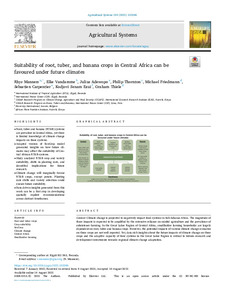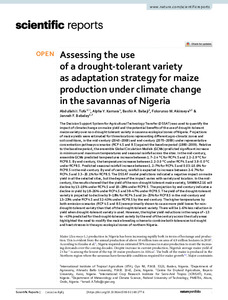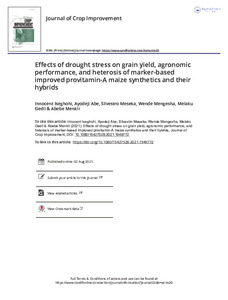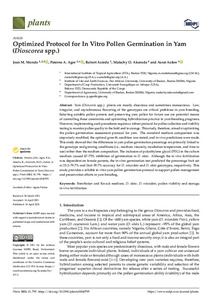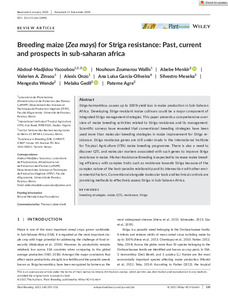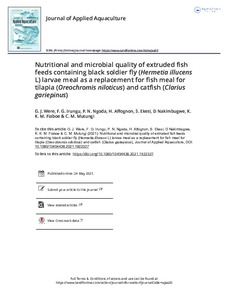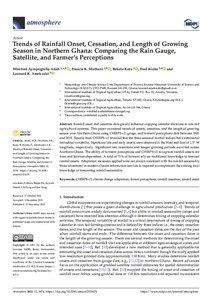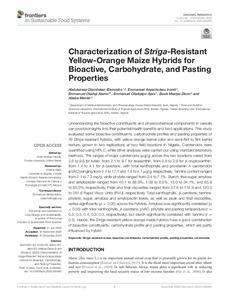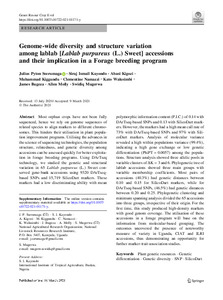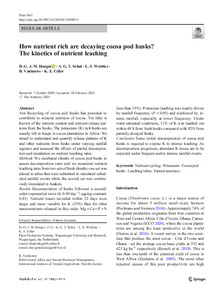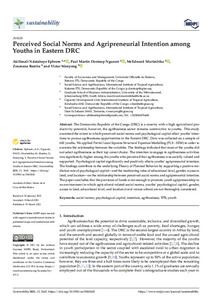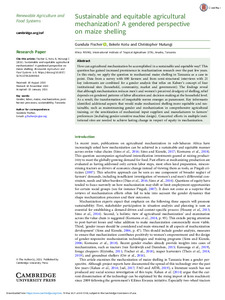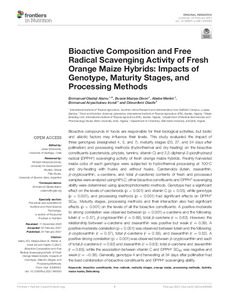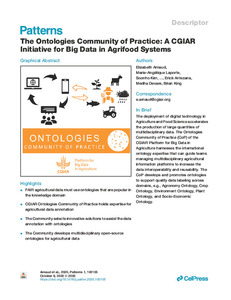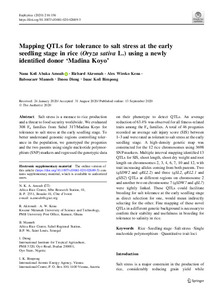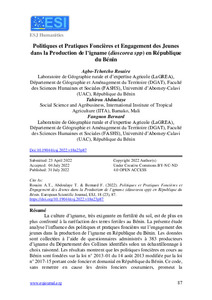Welcome to the International Institute of Tropical Agriculture Research Repository
Journal and Journal Articles: Recent submissions
Now showing items 561-580 of 5266
-
Suitability of root, tuber, and banana crops in Central Africa can be favoured under future climates
(2021-08)Context Climate change is projected to negatively impact food systems in Sub-Saharan Africa. The magnitude of these impacts is expected to be amplified by the extensive reliance on rainfed agriculture and the prevalence of subsistence farming. In the Great Lakes Region of Central Africa, smallholder farming households are largely dependent on root, tuber and banana crops. However, the potential impacts of various climate change scenarios on these crops are not well reported. Yet, data-rich insights ... -
Assessing the use of a drought‑tolerant variety as adaptation strategy for maize production under climate change in the savannas of Nigeria
(2021)The Decision Support System for Agricultural Technology Transfer (DSSAT) was used to quantify the impact of climate change on maize yield and the potential benefits of the use of drought-tolerant maize variety over non-drought tolerant variety in savanna ecological zones of Nigeria. Projections of maize yields were estimated for three locations representing different agro-climatic zones and soil conditions, in the mid-century (2040–2069) and end-century (2070–2099) under representative concentration ... -
Effects of drought stress on grain yield, agronomic performance, and heterosis of marker-based improved provitamin-A maize synthetics and their hybrids
(2021-05-01)Provitamin A-enriched maize (Zea mays L.) is an important complementary food staple for combating vitamin A deficiency (VAD) in high maize-producing and maize-consuming countries of sub-Saharan Africa (SSA). However, frequent drought is a major abiotic factor that retards maize growth, resulting in yearly fluctuations in grain yield. Development of provitamin A-enriched maize varieties resilient to recurrent drought stress could enhance and stabilize maize grain yield. This study was conducted to ... -
Optimized protocol for in vitro pollen germination in yam (Dioscorea spp.)
(2021)Yam (Dioscorea spp.) plants are mostly dioecious and sometimes monoecious. Low, irregular, and asynchronous flowering of the genotypes are critical problems in yam breeding. Selecting suitable pollen parents and preserving yam pollen for future use are potential means of controlling these constraints and optimizing hybridization practice in yam breeding programs. However, implementing such procedures requires a robust protocol for pollen collection and viability testing to monitor pollen quality ... -
Unpacking the value of traditional African vegetables for food and nutrition security
(2021-03-16)There is a need for agriculture in sub-Saharan Africa to diversify into more nutrient-rich crops to meet the subcontinent’snutritional needs in terms of micronutrients and reduce health risks related to high and rising rates of overweight/obesity.Many traditional African vegetables (TAVs) are nutrient-dense and have much potential to reduce malnutrition. These vegetablescan also provide sustainable incomes to rural, urban and peri-urban farming communities. In addition to their high economicvalues ... -
Breeding maize (Zea mays) for striga resistance: past, current and prospects in sub-Saharan Africa
(2021-04)Striga hermonthica, causes up to 100% yield loss in maize production in Sub‐Saharan Africa. Developing Striga‐resistant maize cultivars could be a major component of integrated Striga management strategies. This paper presents a comprehensive overview of maize breeding activities related to Striga resistance and its management. Scientific surveys have revealed that conventional breeding strategies have been used more than molecular breeding strategies in maize improvement for Striga resistance. ... -
Nutritional and microbial quality of extruded fish feeds containing black soldier fly (Hermetia illucens L) larvae meal as a replacement for fish meal for tilapia (Oreochromis niloticus) and catfish (Clarius gariepinus)
(2021)The black soldier fly (Hermetia illucens L.) is a potential substitute of fish meal in feeds. However, information on the nutrition and safety of these feeds is inadequate. This study examined the quality of fish feed pellets extruded from blends formulated with and without black soldier fly larval meal (BSFLM). A further aim was to study the influence of extrusion processing types on feed composition. Two iso-proteinous feed blends containing 28% protein were formulated with 0% BSFLM (BSFLM0) and ... -
Trends of rainfall onset, cessation, and length of growing season in northern Ghana: comparing the rain gauge, satellite, and farmer's perceptions
(2021-12-13)Rainfall onset and cessation date greatly influence cropping calendar decisions in rain-fed agricultural systems. This paper examined trends of onsets, cessation, and the length of growing season over Northern Ghana using CHIRPS-v2, gauge, and farmers’ perceptions data between 1981 and 2019. Results from CHIRPS-v2 revealed that the three seasonal rainfall indices have substantial latitudinal variability. Significant late and early onsets were observed at the West and East of 1.5◦ W longitude, ... -
Characterization of striga-resistant yellow-orange maize hybrids for bioactive, carbohydrate and pasting properties
(2020)Understanding the bioactive constituents and physicochemical components in cereals can provide insights into their potential health benefits and food applications. This study evaluated some bioactive constituents, carbohydrate profiles and pasting properties of 16 Striga-resistant hybrids, with yellow-orange kernel color and semi-flint to flint kernel texture, grown in two replications at two field locations in Nigeria. Carotenoids were quantified using HPLC, while other analyses were carried out ... -
Determining and managing maize yield gaps in Rwanda
(2020)Smallholder maize growers are experiencing significant yield gaps due to sub-optimal agricultural practices. Adequate agricultural inputs, particularly nutrient amendments and best management practices, are essential to reverse this trend. There is a need to understand the cause of variations in maize yield, provide reliable early estimates of yields, and make necessary recommendations for fertilizer applications. Maize yield prediction and estimates of yield gaps using objective and spatial ... -
Effluent quality of wet process coffee processing factories in coffee growing ecological zones in Burundi
(2020)Arabica coffee is cultivated by smallholders for commercial purposes, and it is commonly processed using wet Coffee Processing Technology. Burundi has more than 250 Coffee Processing factories which discharge their effluents to water bodies. The goal of this study was to determine the levels of physicochemical parameters in wastewater from Coffee Processing Technology factories in major coffee growing ecological zones in Burundi. Wastewater samples were collected from 19 sites representing private, ... -
Genome-wide diversity and structure variation among lablab [Lablab purpureus (L.) Sweet] accessions and their implication in a forage breeding program
(2021)Most orphan crops have not been fully sequenced, hence we rely on genome sequences of related species to align markers to different chromosomes. This hinders their utilisation in plant population improvement programs. Utilising the advances in the science of sequencing technologies, the population structure, relatedness, and genetic diversity among accessions can be assessed quickly for better exploitation in forage breeding programs. Using DArTseq technology, we studied the genetic and structural ... -
Impact of soil acidity and liming on soybean (Glycine max) nodulation and nitrogen fixation in Kenyan soils
(2020-11)There is a wide application of rhizobia inoculants to legume crops in Africa, irrespective of the soil acidity, though the latter limits the effectiveness of inoculants. Two trials were conducted in a controlled environment to determine suitable soil pH and impact of liming on soybean nodulation and nitrogen fixation to inform proper application of the rhizobia-inoculant technology on acid soils. In the first trial; soil, variety and inoculation had significant influence (p < 0.05) on weighed ... -
How nutrient rich are decaying cocoa pod husks? The kinetics of nutrient leaching
(2021)Aim Recycling of cocoa pod husks has potential to contribute to mineral nutrition of cocoa. Yet little is known of the nutrient content and nutrient release patterns from the husks. The potassium (K) rich husks are usually left in heaps in cocoa plantations in Africa. We aimed to understand and quantify release patterns of K and other nutrients from husks under varying rainfall regimes and assessed the effects of partial decomposition and inundation on nutrient leaching rates. Methods We incubated ... -
Perceived social norms and agripreneurial intention among youths in eastern DRC
(2021)The Democratic Republic of the Congo (DRC) is a country with a high agricultural productivity potential; however, the agribusiness sector remains unattractive to youths. This study examined the extent to which perceived social norms and psychological capital affect youths’ intentions to pursue agribusiness opportunities in the Eastern DRC. Data was collected on a sample of 600 youths. We applied Partial Least Squares Structural Equation Modelling (PLS−SEM) in order to examine the relationship ... -
Sustainable and equitable agricultural mechanization? A gendered perspective on maize shelling
(2021-08)How can agricultural mechanization be accomplished in a sustainable and equitable way? This question has gained increased prominence in mechanization research over the past few years. In this study, we apply the question to mechanized maize shelling in Tanzania as a case in point. Data from a survey with 400 farmers and from semi-structured interviews with 21 key informants are combined for a gender analysis that relies on Kabeer's concept of four institutional sites (household, community, market ... -
Bioactive composition and free radical scavenging activity of fresh orange maize hybrids: impacts of genotype, maturity stages, and processing methods
(2021-02-24)Bioactive compounds in foods are responsible for their biological activities, but biotic and abiotic factors may influence their levels. This study evaluated the impact of three genotypes (designated 4, 5, and 7), maturity stages (20, 27, and 34 days after pollination) and processing methods (hydrothermal and dry-heating) on the bioactive constituents (carotenoids, phytate, tannins, vitamin C) and 2,2-diphenyl-2-picrylhydrazyl radical (DPPH*) scavenging activity of fresh orange maize hybrids. ... -
The ontologies community of practice: a CGIAR initiative for big data in agrifood systems
(2020-10-09)The Bigger Picture Digital technology use in agriculture and agrifood systems research accelerates the production of multidisciplinary data, which spans genetics, environment, agroecology, biology, and socio-economics. Quality labeling of data secures its online findability, reusability, interoperability, and reliable interpretation, through controlled vocabularies organized into meaningful and computer-readable knowledge domains called ontologies. There is currently no full set of recommended ... -
Mapping QTLs for tolerance to salt stress at the early seedling stage in rice (Oryza sativa L.) using a newly identified donor ‘Madina Koyo’
(2020)Salt stress is a menace to rice production and a threat to food security worldwide. We evaluated 308 F4 families from Sahel 317/Madina Koyo for tolerance to salt stress at the early seedling stage. To better understand genomic regions controlling tolerance in the population, we genotyped the progenies and the two parents using single nucleotide polymorphism (SNP) markers and regressed the genotypic data on their phenotype to detect QTLs. An average reduction of 63.4% was observed for all fitness-related ... -
Politiques et pratiques foncieres et engagement des jeunes dans la production de l'igname (dioscorea spp) en Republique du Benin. Land policies and practices and youth engagement in yam (dioscorea spp) production in the Republic of Benin
(2022)La culture d’igname, très exigeante en fertilité du sol, est de plus en plus confronté à la raréfaction des terres fertiles au Bénin. La présente étude analyse l’influence des politiques et pratiques foncières sur l’engagement des jeunes dans la production de l’igname en République du Bénin. Les données sont collectées à l’aide de questionnaires administrés à 383 producteurs d’igname du Département des Collines identifiés selon un échantillonnage à choix raisonné. Les résultats montrent que les ...

